Home
Did Chamorro Men Fight in the U.S. Civil War?
- Details
- Written by: Bernard Punzalan
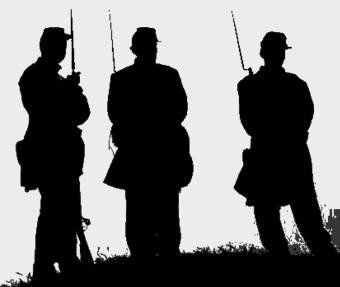
Many Chamorro Whalers, aka Bayineros, sailed on a variety of vessels across the globe, for opportunity, adventure, and other personal reasons. Some returned home, while others continued to journey and settled elsewhere.
Until recently, the question of whether Chamorro men fought in the U.S. Civil War did not dawn on me until I came across the military record of Private Peter Sontos (Santos); sometimes also recorded as Peter Santas or Peter Santee.
Previously, I reported that 23 men that were listed with Guam as their birth place joined the US Navy in the 1800’s. Little did I realize they were all enlistments that occurred during the period of the civil war, between 1861-1865 for in the Union's Navy.
Santos’ journey appears to be a rare one compared to his peers in that he has a record of mustering up for the Union’s Army in 1865. His records indicate that he was a “substitute.” According to the National Archives and Records Administration, men drafted during the civil war could hire a substitute to fight in their place, provided they had the means to do so. A couple of other military substitutes I tracked down and with Guam as their birth place were Benjamin Button and Alonzo Ernandes. But these two enlisted in the U.S. Navy for the Union as well.
On March 23, 1865, Santos appeared for muster and enlisted into the Union’s Army, in Portland, Maine. His enlistment was as a substitute in for Joseph W. Nutter. Based on Census documents Nutter was a Caucasian farmer from Newfield Town, Maine. As part of his enlistment, he was assigned to the 43rd Colored Infantry Regiment based out in Pennsylvania.
Santos had nearly two complete months of service; one month before and one month after the Civil War. He mustered out and was honorably discharged on May 15, 1865 under the authority of General Order 77. That General Order was basically an order for the Army to reduce its resources marking the end of the Civil War.
With the current evidence available, it is highly unlikely that he fought in that war. In some of the military records it indicated that Santos was not paid a bounty for his service. But, I wonder if Santos was paid by Nutter to substitute for him or if he did it as a favor or possibly even a reciprocated/debt payment to Nutter.
But still, I am left wondering...did Chamorro men fight in the U.S. Civil War?
I think this would make a great topic for a young Chamorro scholar to pursue, investigate and write her/his findings!
Bibliography
Ersland, Jake. (undated). Civil War Provost Marshal Records: A Snapshot in Time. National Archives Records Administration.
Maine, State Archive Collections, 1718-1957.
National Park Service Civil War Soldiers and Sailors System. http://www.nps.gov/civilwar/soldiers-and-sailors-database.htm
National Archive Records Administration (NARA).
Roque Santos Matagulay (1931-1999)
- Details
- Written by: Bernard Punzalan
Du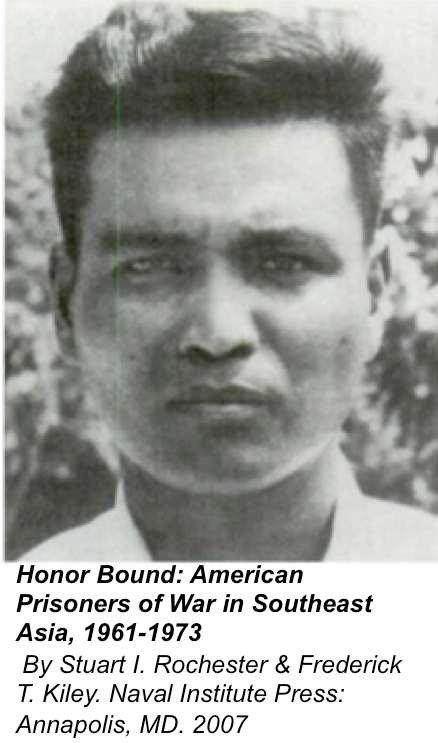 ring the Viet Nam Era, Army Sergeant First Class Roque Santos Matagulay was a prisoner of war for 155 days in 1962. News reports state that on July 23, 1962, he and another fellow soldier were ambushed by Communist guerrilas while hunting off-duty for deer near Pahn Theit, South Viet Nam. At the time, Matagulay was on an assignment as a military advisor to the Vietnamese military.
ring the Viet Nam Era, Army Sergeant First Class Roque Santos Matagulay was a prisoner of war for 155 days in 1962. News reports state that on July 23, 1962, he and another fellow soldier were ambushed by Communist guerrilas while hunting off-duty for deer near Pahn Theit, South Viet Nam. At the time, Matagulay was on an assignment as a military advisor to the Vietnamese military.
During his captivity he was tied up and constantly reminded that he would be killed if he made the slightest effort to escape. Although, he did not receive physical torture, he was subjected to eight solid hours of political indoctrination and interrogation on a daily basis. He was forced to listen to the English-language broadcasts on Communist North Viet Nam's Radio Hanoi three times a day and was regularly tested on what they had to say about the world situation.
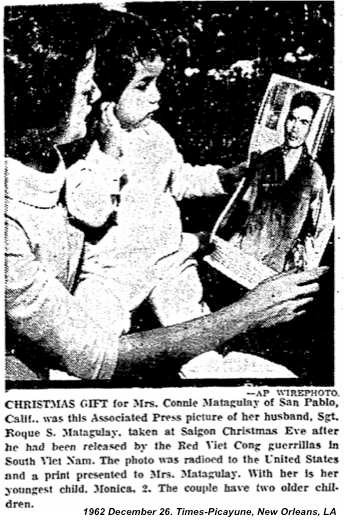 As a POW he contracted Malaria and lost about 40 pounds due to prison conditions. While under physical and mental duress he was coerced into signing adverse statements about the U.S. and South Viet Nam government.
As a POW he contracted Malaria and lost about 40 pounds due to prison conditions. While under physical and mental duress he was coerced into signing adverse statements about the U.S. and South Viet Nam government.
On the Christmas Eve of 1962, he was released by the guerillas. Prior to doing so the guerrillas held a release ceremony, which included 400 soldiers, villagers, women and children to witness what they deemed was an act of generosity to their prisoner. They put Matagulay on a bus and sent him back to his freedom.
Matagulay retired as a Master Sergeant in 1971 after serving 20 years on active duty in the Army. Matagulay died in 1999 and is now buried at the Arlington National Cemetery.
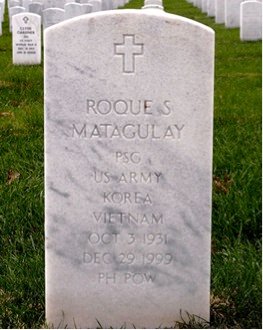
Bibliography
____. 1962. Associated Press via Times-Picayune. New Orleans, LA.
____. 1963. World: Rice & Rats. Time Magazine.
____. Find A Grave retrieved September 15, 2014 from: http://www.findagrave.com/cgi-bin/fg.cgi?page=gr&;GRid=958449
Stuart I. Rochester & Frederick T. Kiley 2007. Honor Bound: American Prisoners of War in Southeast Asia, 1961-1973. Naval Institute Press: Anapolis, MD.
John Anderson’s Account of Roberton and the Hidden Treasure Story
- Details
- Written by: Bernard Punzalan
I recently accessed an 1848 article printed in “The Friend,” an old but defunct newspaper organization that was located Honolulu, Hawaii. The article was titled, “A Narrative of Capt. Roberton, the Treasure Hider,” by Blue Water.
Frankly, I was vaguely aware of the hidden treasure story from past literature. At the time, I was not that drawn to the subject until I came across the subject article. After all, my primary interests and focus is on Chamorro and my genealogy. Low and behold to my surprise within the subject article as I read it I saw my great-great-great grandfather’s name: John Anderson (click to find out more about John Anderson husband of Josefa dela Cruz).
Within the article, John Anderson’s narrative was provided and reprinted in this article regarding Andrew Gordon Roberton and the hidden treasure. Anderson mentions a native of Guam named “Matemy.” Matemy was part of crew that untied Captain Smith and his crew after being bounded by Roberton and his crew. Not much else is said about Matemy after that.
In some accounts it is said that Spanish Governor Jose Ganga Herrero sent up to 600 Chamorros to try and find the buried treasure on Pagan, but were not successful. It is also interesting to note that some literature suggests that the treasure was buried in Agrihan. But nonetheless and to this very day no one has ever found the alleged hidden treasure.
I have included image extracts of my two primary sources from the 1800s where you can read about this interesting story.
(Note: To view a larger format of the image, after clicking on the image, click the icon in the upper right hand corner to enlargen the image)
Bibiliography
___. 1828. Capt. Roberton, A Pirate. The Asiatic Journal and Monthly Register for British India and it Dependencies, Vol. XXVI, July to December 1828, pp. 350-352. Parbury, Allen & Co.: London.
Blue Water. 1848. A Narrative of Capt. Roberton, the Treasure Hider. The Friend: Honolulu, Hawaii.
Obituaries: Natives of Guam Whalers in the 1800’s
- Details
- Written by: Bernard Punzalan
The Friend was a newspaper out of Honolulu, Hawaii from 1845 to 1954. It contained quite a bit of information regarding whaling ships and even obituaries of whaling crews. In some cases the names of the deceased were not mentioned, rather just the fact the person was “a native of Guam,” and in most cases the name of the whaling ship they served as crew.
Below are some extracted samples of those obituaries exclusively from the Friend in the 1800’s. They include:
- Joseph Castro
- Marion
- George Mariana
- John Gozlina
- Silvia Alvers
- Raymond Santos
- Lewis Martinez
- Bicenta Mahone
- Sylvester Castro Zablan
- Juan Guerrero
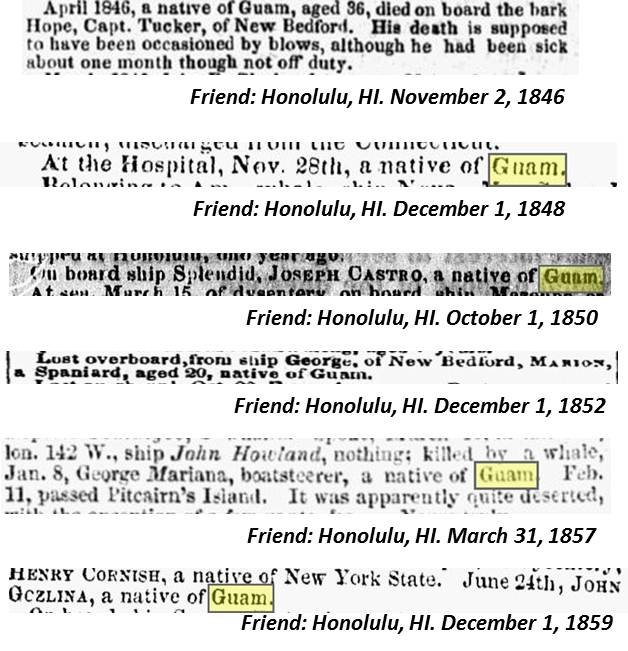

Database Update 10 September 2014
- Details
- Written by: Bernard Punzalan
The database has been updated and has grown from 318,954 to 320,164 names.
Page 47 of 81

